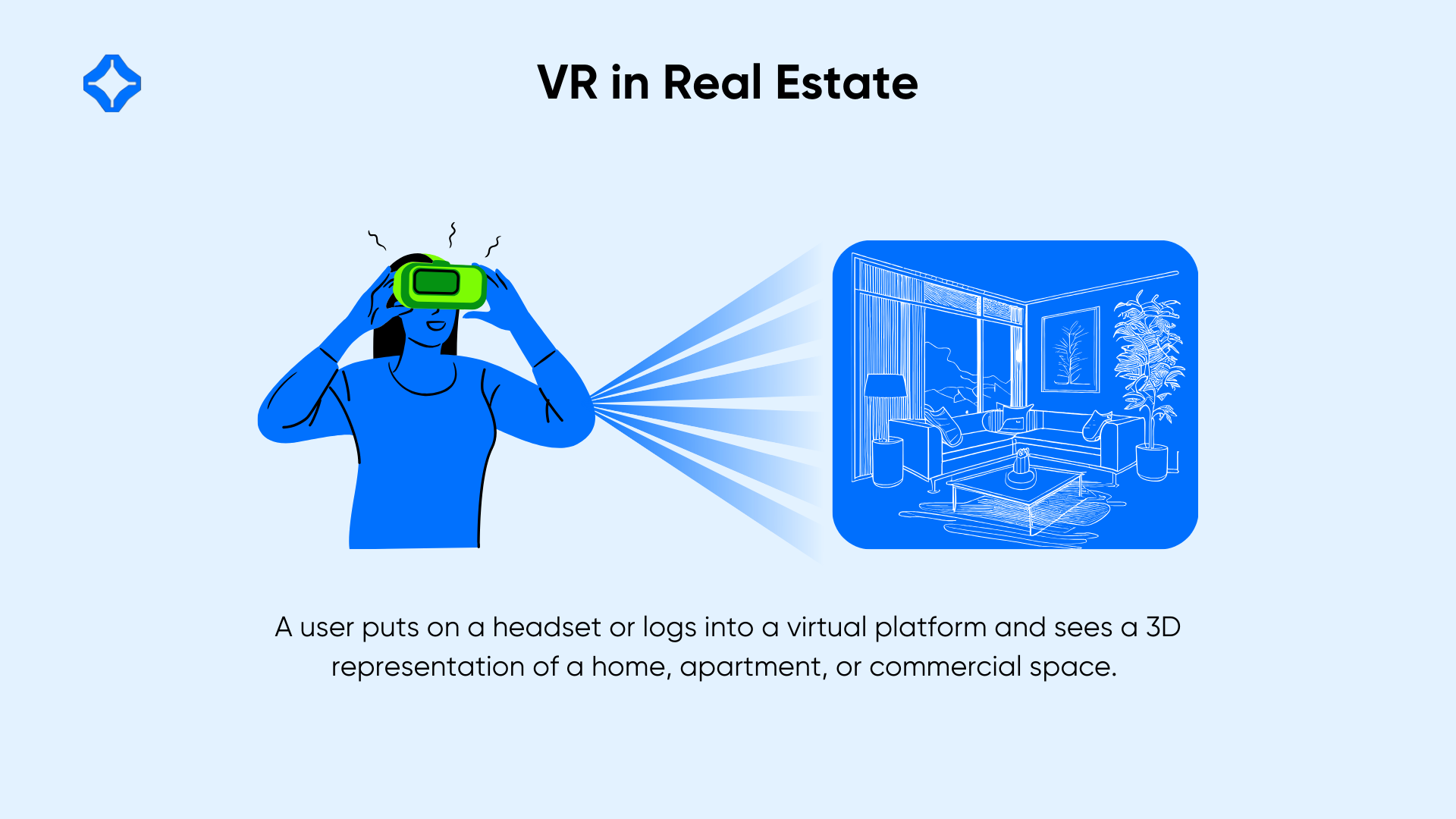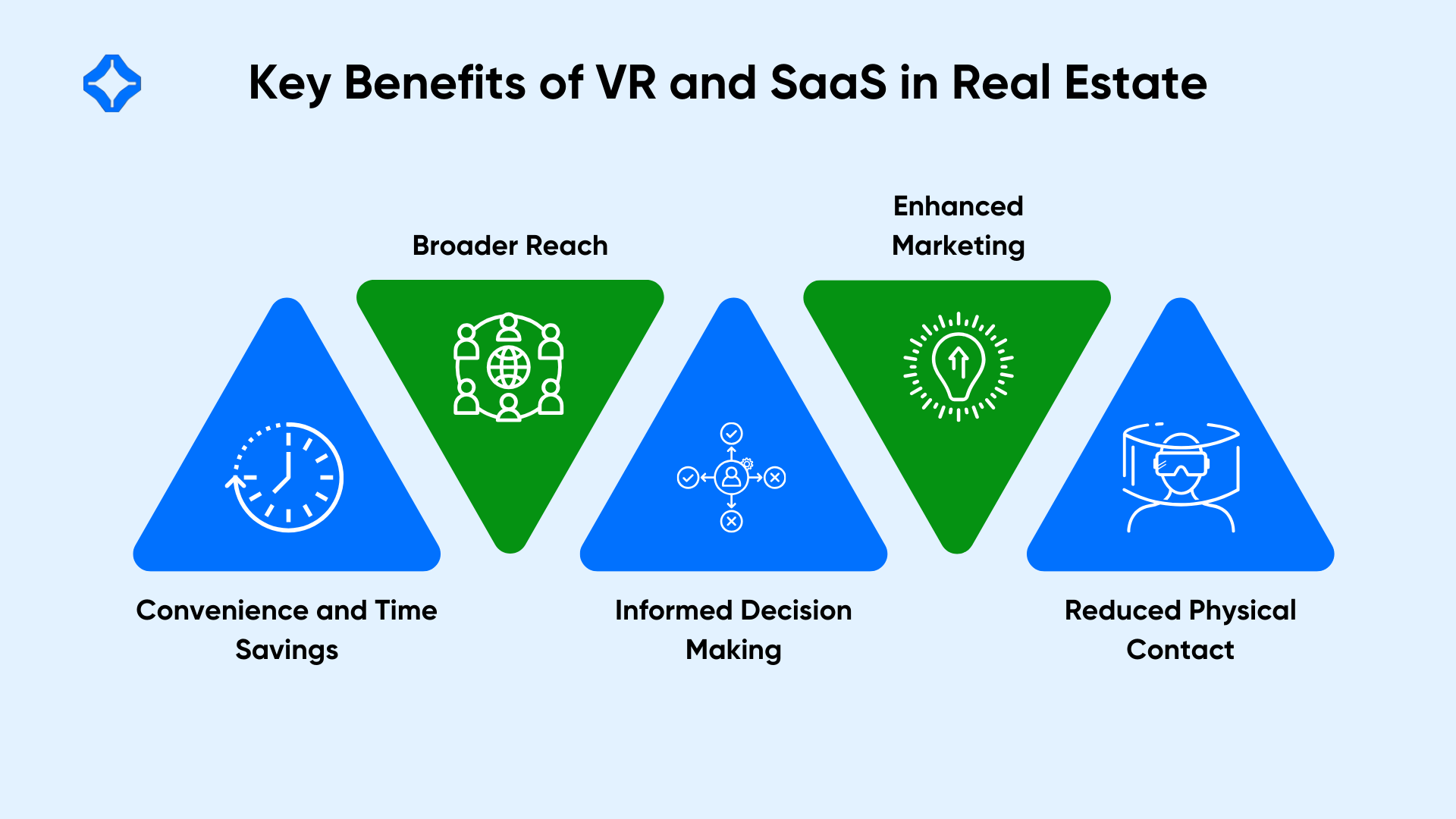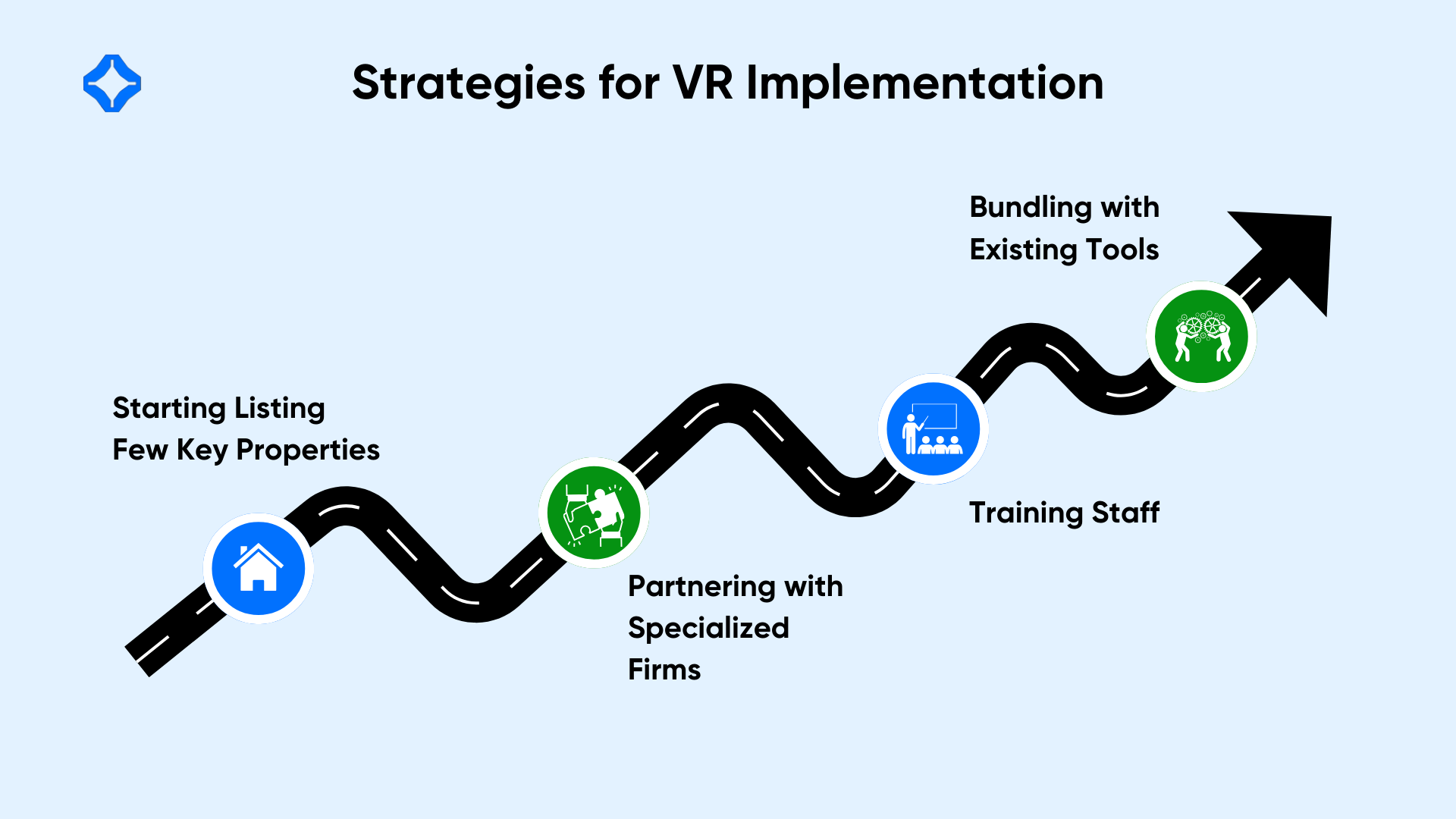Physical real estate tours have long been the norm. People visit properties with agents, walk through each room, and gauge whether a space fits their needs. That process can be costly and time-consuming, especially for buyers or renters who live far away.
Virtual Reality (VR) and Software-as-a-Service (SaaS) solutions now offer a more convenient way to explore properties. They allow users to view high-quality, immersive tours from anywhere.
A potential buyer in one region can preview listings in distant markets without a single flight. Property managers showcase multiple units, often within a single day, by sending links or VR headset files. Below, we explore how VR and SaaS combine to change real estate tours, covering their benefits, challenges, and likely path forward.
Understanding VR in Real Estate

Virtual Reality sets the stage for immersive property exploration. A user puts on a headset or logs into a virtual platform and sees a 3D representation of a home, apartment, or commercial space.
This digital model often includes detailed textures, lighting, and accurate room measurements. Some systems let viewers “walk” or “teleport” from room to room, mimicking a real visit. These experiences provide a sense of depth that 2D images or videos cannot match.
Early VR tours relied on panoramic images or basic 3D modeling. Now, modern cameras and software capture full layouts with accurate proportions. The technology stitches images together, creating a seamless environment.
A potential buyer can pause in the living room, glance around with a VR controller, and then move to the kitchen. This approach reveals the size, shape, and flow of each area more realistically than static photos.
VR tours do not require fancy headsets for every user. Some platforms let viewers navigate through a web browser or mobile app. Although this approach may lack full immersion, it still simulates 3D depth to a degree.
Web-based VR solutions can offer interactive hotspots, property data pop-ups, or live text chat with agents. These features boost user engagement without demanding specialized equipment.
The Role of SaaS in Virtual Real Estate Tours
Software-as-a-Service offers on-demand tools for creating, hosting, and viewing VR tours. Instead of buying local servers or complex applications, real estate professionals subscribe to online platforms. These platforms handle data storage, updates, and security on the back end.
The agent or property manager simply uploads images, 3D scans, or videos to the service. Within hours or days, they have a polished tour ready for prospects. SaaS-based VR solutions often integrate with other real estate systems, such as listing websites or CRM platforms. This allows agents to share a VR link in emails or embed it in property listings.
The cloud-based nature of SaaS simplifies scaling. An agency with a handful of tours pays for one plan, while a national brokerage uploading hundreds of tours can switch to a plan that supports large volumes.
Updates become easier under a SaaS model. Providers roll out new features, bug fixes, or security enhancements automatically. Users benefit from each improvement as soon as it goes live. No special IT staff is needed to install patches. Real estate professionals can focus on their sales and client relations rather than software upkeep.
Combining VR and SaaS for Real Estate Tours
VR content can be large. High-resolution scans, panoramic images, and advanced 3D models occupy considerable data space. SaaS solutions handle the heavy lifting on remote servers, so local machines do not need high processing power.
A user’s device streams the VR environment from the cloud, whether on a headset, laptop, or mobile app. This arrangement reduces hardware constraints and speeds up the entire pipeline.
Agents or brokers can upload property data using a SaaS interface. The system converts raw media into an interactive 3D tour. It might add hotspots that reveal floor plans or highlight custom elements like built-in shelves.
Some platforms use advanced techniques to produce realistic lighting and shading, adding an extra layer of detail. Adopting a headless CMS for e-commerce approach can deliver 3D listings fast, ensuring consistent branding and smooth load times. Once the tour is ready, the system shares a link with prospective clients. Viewers experience near real-time rendering thanks to robust cloud computing.
The same SaaS platform can track user engagement. Agents learn how many people accessed each tour, how long they spent, and which rooms drew the most interest. This data guides future marketing strategies.
If viewers spend more time in the kitchen, the agent might add more details about appliances or improvements. SaaS dashboards offer immediate insights, allowing professionals to refine approaches for upcoming listings.
Key Benefits of VR and SaaS in Real Estate

Convenience and Time Savings
Traveling to multiple listings in person can consume days or weeks. VR tours let buyers narrow their choices remotely. They visit one or two finalist properties in person instead of ten or more. This efficiency benefits both parties. Sellers welcome fewer wasted showings, while buyers invest less time into fruitless visits.
Broader Reach
Real estate is no longer limited by location. A client from another city or country can explore a listing as if they were there. Some overseas buyers finalize deals without ever setting foot on the property, relying on VR tours and thorough inspections. Agents expand their audience beyond local boundaries, possibly finding more competitive offers.
Informed Decision Making
High-quality VR experiences show precise layouts, room sizes, and lighting conditions. Clients form stronger opinions of whether a space fits their needs. A small bedroom or narrow hallway becomes obvious in VR, while photographs can be misleading. This transparency helps manage expectations and reduce disappointment during on-site visits.
Enhanced Marketing
Properties that include VR tours often stand out in online listings. Interactive content that extends beyond simple images captivates viewers. Agents may see increased click-through rates or inquiries when they feature a 3D walkthrough. The novelty factor also boosts brand reputation, positioning the agent as tech-savvy.
Reduced Physical Contact
Health and safety concerns can influence home buying. Virtual tours let people screen multiple options without physical interactions. Elderly or immunocompromised clients gain peace of mind. Even after pandemic-related restrictions eased in many regions, some clients still prefer VR previews to limit contact with strangers.
Challenges in Adopting VR and SaaS for Real Estate Tours
Technical Barriers
Creating a convincing VR experience takes effort. Agents need proper cameras or scanning tools. Some methods call for 360-degree cameras; others rely on laser-based scanning devices. These solutions have costs and learning curves. Not all real estate agencies have the budget or tech-savvy staff to deploy them.
Slow internet connections can hamper performance. High-resolution VR content demands strong bandwidth, especially for real-time rendering. If a client’s internet is sluggish, they might see lag or lower visual quality. This detracts from the immersive experience, frustrating potential buyers.
Upfront Costs
Although SaaS reduces the need for on-site infrastructure, capturing VR footage still involves specialized equipment. Some platforms require monthly or annual subscription fees to host 3D tours. The combination of hardware and recurring service costs may deter smaller agencies. They must calculate whether the marketing benefits outweigh these expenses.
Accuracy and Quality
Poorly captured images, mismatched stitching, or low-resolution scans can mislead viewers. If a 360 photo skews the shape of a room, buyers get a flawed impression. Ensuring accurate measurements and consistent color balance can be tricky. Agents may need professionals to process the footage. If the VR tour is subpar, clients might lose trust.
Privacy Concerns
Turning a real property into a virtual model raises questions about privacy. Rooms may contain personal items or sensitive details. In some cases, VR captures can reveal more than standard photos. Homeowners may worry about exposing too many details to the public. Agents should discuss how to stage or remove certain items before scanning with sellers.
Strategies for VR Implementation

Starting Small
Agents can begin with a single listing or a few key properties. This pilot approach helps them learn the creation process, practice editing VR tours, and gauge client reactions. If results are positive, they can scale up to more listings or advanced features, such as interactive hotspots or voice narration.
Partnering with Specialized Firms
Businesses that offer VR capture as a service can assist real estate agencies. They bring high-end gear, handle processing, and deliver polished tours. Agents avoid the upfront equipment cost and the hassle of learning scanning techniques. They pay the partner per project or based on monthly usage. This path often suits agencies lacking internal tech expertise.
Training Staff
Staff should understand the basics of VR whether an agency does VR scanning in-house or uses an external firm. Agents need to explain VR tours to clients, troubleshoot minor issues, and interpret analytics. Some SaaS vendors provide tutorials or live training. If staff comprehend the technology, they can guide prospects more effectively.
Bundling with Existing Tools
SaaS VR solutions often integrate with listing platforms, CRM software, or digital marketing suites. Agents can embed VR links in standard property pages or email campaigns. Once a user finishes a tour, the system might prompt them to fill out a contact form. Data then syncs with the agent’s CRM. This creates a cohesive lead funnel that merges VR analytics with standard performance metrics.
The Future of VR-SaaS Real Estate
Advanced Interactivity
Today’s VR tours already allow panning and zooming. Future developments may include interactive furniture staging or color changes. Potential buyers could see how a living room looks with different wall paint or floor materials.
By integrating generative AI in VR tours, agents can showcase alternate room designs or staged furniture to help buyers visualize potential makeovers. By letting them alter the environment, these tours become even more personal. They visualize potential renovations instantly.
AI-Powered Insights
SaaS platforms that analyze user behavior can generate AI insights. They track which areas viewers spend the most time examining. If repeated watchers always linger near the windows, the agent might add details about the view or local landscaping.
Automated suggestions help refine listings, highlight strong points, or address common concerns. AI-driven recommendations could also propose additional properties that match a user’s preferences.
Improved Hardware Accessibility
VR headsets may become lighter, more affordable, and more user-friendly. This broader adoption would encourage more immersive tours. Technology companies may develop specialized real estate VR kits that are pre-configured with scanning devices and integrate with popular listing sites.
Global Collaboration
Property investors worldwide already rely on digital channels to find opportunities. VR tours, combined with SaaS features like live chat or co-viewing sessions, will let multiple stakeholders examine a property at once. An agent, investor, and contractor could “walk” through the space from different countries, marking issues or discussing potential changes in real time.
Conclusion
VR and SaaS platforms have opened new doors in the real estate industry. Potential buyers can move through properties from their couches while brokers track engagement stats, refine listings, and connect with a global clientele. The synergy of immersive visuals and cloud-based services has made house hunting less stressful and more convenient.
Although there are barriers, including scanning costs and internet speed, the advantages often outweigh the hurdles. VR fosters transparency, letting viewers gauge property details. SaaS ensures a scalable, user-friendly system for hosting tours. As technology advances, we can expect more interactive, data-driven platforms that push the boundaries of traditional showings.
VR tours do not completely replace in-person visits. Buyers still want to sense the atmosphere and confirm features. Yet, these virtual tools do reduce guesswork and wasted travel. They benefit agents by attracting serious, better-informed leads. They also serve sellers who want broader exposure. For many in real estate, VR has become a vital piece of the marketing puzzle.
FAQs
Prices vary. Some 360-degree cameras cost a few hundred dollars, while advanced laser-based devices can reach thousands. Certain real estate firms hire external VR experts or subscribe to services that supply gear and handle the scanning.
Yes. Most modern SaaS VR platforms optimize tours for phones, tablets, or web browsers. While a headset offers deeper immersion, these alternatives provide a good overview, letting users pan around rooms and move through a property with basic touch controls.
It depends on the tour’s quality and the client’s expectations. VR helps filter out mismatched options and highlights top candidates. Many still want at least one in-person walkthrough before closing a deal. Yet, remote buyers sometimes rely on VR alone if they trust the agency’s accuracy and thoroughness.